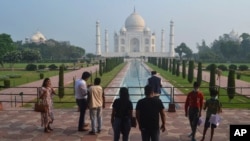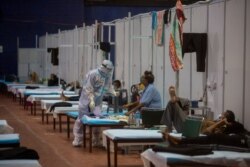India’s iconic 17th century Taj Mahal monument reopened Monday after its longest shutdown even as the country grapples with rising coronavirus cases.
The reopening of the famed white marble Mughal-era monument in Agra town after six months is a signal that the world’s second-worst hit nation by the pandemic will steadily ease restrictions to bring its devastated economy back on track and restore lost livelihoods, observers say.
The long, snaking lines that could seldom be skipped at the Taj Mahal were missing. A visitor from Taiwan and a family from New Delhi were among the first to enter the monument that was sanitized before being opened, according to officials.
Only 5,000 visitors will be allowed a day with restrictions that have become the norm amid the pandemic. “Masks are mandatory to enter the monuments and all tickets must be purchased online. Ticket counters will not be open," according to Vasant Kumar Swarnkar, superintendent at the Archaeological Survey of India in Agra.
Group photos, one of the highlights for families or friends who posed in the lawns outside with the iconic Taj Mahal in the backdrop, will not be allowed to ensure that physical distancing norms are followed, say authorities.
The pandemic led to the monument’s longest shutdown in history – it was briefly closed during the Second World War, in 1971 when India and Pakistan fought a war, and in 1978 when Agra city was flooded.
The Taj Majal’s reopening has brought a glimmer of hope to a tourism-dependent town whose economy revolves around the monument. The major draw for international tourists to India, it attracts seven million visitors a year that include foreign dignitaries. U.S. President Trump made a visit during an official trip to India in February.
“The monument's reopening is a start at least and we hope it will help people overcome the fear that the pandemic has created about traveling. Initially we only expect to see domestic visitors who can drive in their own vehicles from nearby places,” according to Rajiv Tewari, president of the Federation of Travel Association of Agra.
As in most countries, the travel and tourism industry has been battered the worst. In Agra, hotels and restaurants are struggling to stay open, several shops that sold curios and handicrafts have downed shutters and tens of thousands have lost livelihoods.
For Mohammad Shakeel Khan, who made a living as a tour guide, the monument’s reopening has rekindled some optimism, but he said he is unlikely to get work until foreign visitors return. “I have been at home for six months, but until international travel returns to normal, it will be difficult for my work to come back.”
It is the plight of millions like Khan that is prompting India to return to business as usual although it has been reporting the world’s biggest daily jump in cases for some time. India now has nearly 5.5 million infections, according to the Johns Hopkins University, which is tracking the global outbreak. More than 4 million of these cases have been added in the last two months, according to Indian officials.
Markets, businesses and restaurants have opened in most Indian cities, and public transport and domestic flights have largely been restored although international travel is still restricted.
India had imposed the world’s strictest and longest lockdowns in March, hoping it could avert being devastated by the virus, but cases started rising after the restrictions were eased and travel resumed. Although as a proportion of its 1.3 billion population, India’s numbers are still small compared to countries like the United States and Brazil, it is expected to eventually become the worst-hit country by the pandemic.









